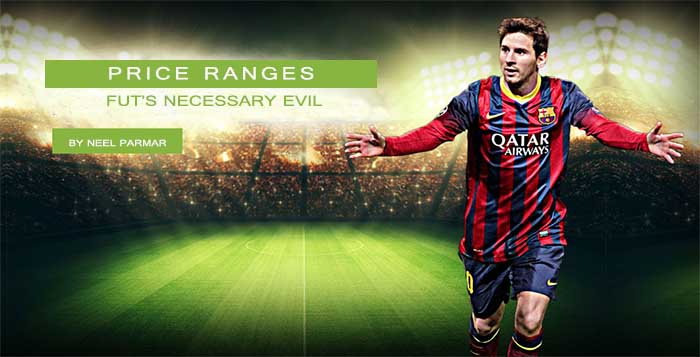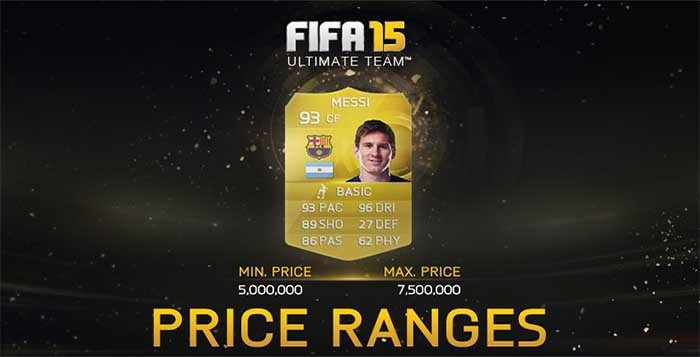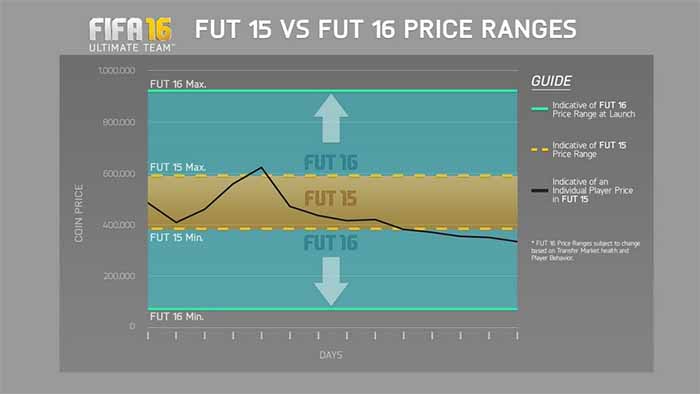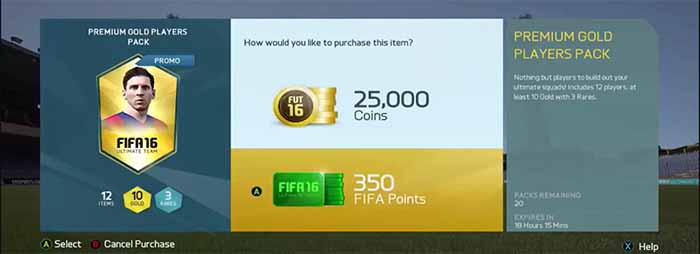Find out why EA have implemented the Price Ranges in FUT.
Price ranges: FUT’s necessary evil
The implementation of price caps midway through the FUT 15 cycle was met with much uproar and negativity. With coin traders becoming rampant among FUT and hacking software being used to generate millions of coins in FUT on older consoles, inflation was becoming a serious issue whilst normal players who didn’t buy packs or FIFA points were left behind, unable to keep up with the changes. EA needed to act fast to counteract the issue and, in their opinion, price caps were the only way.
Price caps, also known as price ranges or price ceilings/floors, was a system introduced by EA to directly combat illegal coin buying and selling. It meant that players could be bought/sold for a limited value relative to their market clearing value. Coin sellers would typically buy a customer’s worthless player for millions of coins to easily transfer the coins but the new system meant this could no longer be done, at least not with the same amount of efficiency. It meant that to buy 2 million coins you had to sell a player worth 1.5 million rather than 150 coins, meaning users were severely impaired when buying coins.
Of course, it wasn’t a smooth transition as many players became extinct due to their price limit being too low hence users would earn too little from selling their player relative to their actual worth to justify the transaction. At the other extreme, players would not sell as they had a price floor set too high, i.e well above their actual value. An example was Daniel Sturridge who on PS consoles was initially worth 20k but after price caps were introduced, could not be sold for less than 30k. Users simply didn’t feel as though these players were good enough value for money hence they were never bought.
So why did these issues come about? In short it was a combination of two things: EA’s poor knowledge of the market and player values in combination with cross platform price cap equality. As you probably know, the Playstation, Xbox and PC market all behave differently, but EA lazily set price caps to be the same across all platforms. The result? Some players who were reasonable priced on one console would be unreasonably priced on another. Chaos ensued as hundreds of FUT cards went extinct or became too expensive while EA struggled to make the instant changes as necessary.
The real stinger for EA is that this didn’t stop coin selling websites in their tracks, rather it slowed them down briefly. People soon realised that EA’s anti-coin buying system of three strikes was a hollow threat as only one out of hundreds were caught. Secondly, sellers introduced new methods of transfer including selling pre-loaded accounts and comfort trades. As every “worthless” item was still allowed to be sold for up to 5000 coins, sellers simply bought hundreds of these items off a coin-buyer to make up a larger transaction.
In EA’s defence, there was little they could do to stop illegal coin buying from occurring in the first place. The old-gen consoles, PS3 and Xbox 360, were more susceptible than next gen consoles to hacking software and using “bots” to auto-trade. Secondly, people saw the ability to make money off this and money make the world go around so why wouldn’t they do it. Lastly, the internet is a big place so EA would have a difficult task tracking down and shutting down these con selling websites. Although, it makes you wonder why EA couldn’t have done better given the sheer amount of money they make each year from FIFA.
With the arrival of FIFA 16, EA have done their best to improve how price ranges affect the market. The most important change was the splitting of markets across all consoles. This was important as it meant hacked coins from old-gen consoles couldn’t be sold to next-gen users (typically the preferred consoles of buyers). However this came at the inconvenience of those who wanted to upgrade console during the FIFA 16 cycle.
Secondly, EA now understand the market and how it works better hence were able to widen price ranges as such. Previously, players were susceptible to having their real value move outside the narrow price range and become super-saturated or extinct as a result. Now, with larger margins either side of a player’s market clearing value, I cannot personally say I have ever seen this happen in 16.
Also, EA have a better stranglehold on coin-selling websites and have been able to limit their ability to sell coins, especially to next gen. This includes stricter detection for potential users which may actually be bots. However, these sites are getting smarter to EA’s tactics reflected by falling coin prices as the supply of illegal coins grows.
Finally, it is worth talking about FIFA points and how they have contributed to this problem. Many people who bought coins were willing to spend money on FIFA but felt that the value of FIFA points was not good enough to justify buying them. This is reflected by youtubers an their “pack openings” where tens or even hundreds of dollars of FIFA points often yields a return of less than half the coin value of the packs opened. Users would rather guarantee they are getting good amounts of coins by buying them directly. However, youtubers among many other users’ willingness to spend obscene amounts of money on FIFA points every week means EA has no incentive to change their sky-high pricing regime. With trading compromised by price ranges as there is less potential to find a bargain buy, smart traders aren’t getting the best teams, those who buy mountains of FIFA points are.
The only way to stop EA in their tracks is a revolt to buying FIFA points. EA earn more from micro-transactions (site article) in FIFA than from selling the game itself. If this continues, nothing will change but an end to paying obscene amounts for FIFA points can only happen if stop buying them for now.
The Author: Neel Parmar
Neel grew up playing various video games of all genres, but in the past few years has grown an increasing passion for FIFA in particular.
With his extensive knowledge of the ever popular FUT game-mode, he naturally wants to share it with the FIFA community.
Despite pursuing a degree in science, he always had a penchant for writing and has had letters to editors published in popular magazines as well as contributing to FIFA based websites.
Neel is keenly interested in all things football related, be it on the real or virtual pitch, and is an avid Barcelona fan.



